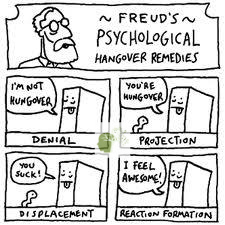Seeing the World Through Our Defense Mechanisms
Every day we live our lives doing our usual stuff, waking the morning to go whether to our jobs, to the university, or simply to get into the grocery store to grab something for tonight’s dinner. Whether or not we engage into a solitary activity or an activity that involves other people, we live our lives based on the defense mechanisms that that we unconsciously (outside of awareness) use to interact with others.
Let me offer a more thorough definition of what we actually mean with defense mechanisms. Its origins could be traced in the theory of psychoanalysis, based on the theory of the Viennese physician and the father of psychoanalysis, Sigmund Freud. According to this perspective, there are psychological strategies that are employed by the unconscious mind to distort, manipulate, or deny a certain reality of the person. This is done to guard feelings of anxiety and possible impulses in order to emotionally protect one’s self. It is noteworthy that, even though it was Sigmund Freud who was the initial proposer of these mechanisms, his daughter Anna along with other psychoanalysts continued and enhanced further types of ego defenses (Freud, 1937).
These defense mechanisms that we use are not necessarily good or bad. Specifically, according to George Eman Vaillant (1992), they are classified into four levels: Pathological, Immature, Neurotic, and Mature. The mechanism can become maladaptive to one’s self only if their persistent use negatively affects the physical or mental health and individuality of the person.
Let us proceed to have a closer look at those mechanisms. On the pathological level there are certain mechanisms that could be said to be functioning in an extreme level, having as a result for one to appear as an unstable and an irrational person. These could, also, be called the “psychotic” defenses.
- Splitting. Impulses that are both helpful and hurtful appear to be split off and are projected into someone else. There is no room for doubt and uncertainty since everything in the world is seen as all good or all bad and nothing in between. In other words, everything is black and white, with no grey as an option – not even a shade.
- Conversion. The manifestation of intrapsychic conflict into a physical symptom. This could be some kind of paralysis, numbness, cough, etc. The name of this mechanism has as its root the term ‘convert’ which essentially means that repressed impulses are converted or turned into a physical symptom, mainly neurological in nature. The symptom is easily localized (see Somatization below to check out the difference).
- Delusional Projection. This mechanism is regarding persecutory delusions. Specifically, according to psychiatrist and philosopher Karl Jaspers, for a belief to be considered delusional three criteria should be met: certainty, unalterable (not changed even if evidence are presented to the contrary), and impos
 sibility of the delusional content.
sibility of the delusional content. - Denial. As the name implies, there is a refusal to accept external reality due to its threatening nature. By refusing to acknowledge an unpleasant aspect of external reality has as a result a reduction of anxiety.
- Distortion. A major reshaping of the external reality to meet one’s own needs
- Extreme Projection. An ignorance of one’s own psychological deficiency, which is perceived as a deficiency to another person.
In the second level belong the immature defense mechanisms. They are called immature simply because they are seen as socially undesirable because they are difficult to deal with, are out of touch with reality and lead to affect negatively one’s ability to cope effectively. They are mostly seen in major depression and personality disorders:
- Somatization. The transformation of negative feelings towards another individual into negative feelings toward their own self, specifically bodily symptoms. Essentially this is an unconscious rechanneling of bottled-up emotions into somatic symptoms. Many different bodily areas may be identified.
- Wishful thinking. One’s decisions could be done based on what is pleasing to imagine rather than what is base his or her decision on more rational grounds.
- Projection. Same as the pathological mechanism but in a less extreme format.
- Projective identification. Essentially, one’s feelings that cannot be consciously accessed are projected into the other person in order to evoke the thoughts or feelings that were projected. The feelings projected could be both good and/or bad qualities and the person identifies his or her self with those feelings.
- Passive aggression. Aggression that is expressed towards others in an indirect way such as procrastinating, being resistant, being uncooperative, or ignoring someone when that person has attempted to initiate a conversation. For example, one could avoid direct or clear communication, evading problems, making excuses, blaming others, playing the victim, with sarcasm, and hiding anger.
- Introjection. This happens when a person takes a stimulus in his/her environment and adopts it as his own idea, as a part of his or her own self. For example, a boy could introject the mannerisms of his dad and then replicate those in his interaction with others.
- Idealization. The tendency of a person to perceive the other individual as having more idealized qualities than he or she might actually have, and neglecting the negative ones. For example, a person might idealize their recollections from childhood and fail to think about arguments that point to the negative side.
- Fantasy. The tendency to use fantasy in order to escape reality. This, often, is employed to explore alternatives to situations under stressful and unfortunate conditions having as a result to create unrealistic expectations and lose touch with reality.
- Acting out. Here there is a direct wish or impulse that is expressed without the awareness of the emotion that drives the behavior. The acting is done in antisocial ways and is destructive both to self or others. For example, a person who curses on a busy traffic day or instead of saying “I’m angry with you” the person would throw a book at you or punch something. Self-injury could also be a form of acting out.
The third level of defense mechanisms is considered neurotic because they cause long-term problems in people’s relationships and interaction with others.

- Displacement. A defense mechanism that shifts aggressive impulses to a more acceptable or less threatening person or target. For example, a person yells at her spouse because her boss yelled at her.
- Dissociation. The separation of a feeling that would come together with the situation or with the thought. Usually this happens to people who cope with uncomfortable situations by removing themselves from them. Daydreaming, staring into space and letting their mind to wonder off, are some examples of that mechanism.
- Hypochondriasis. An excessive worry about having a serious illness. For example, one could believe that he has a tumor, but after extensive examinations nothing is evident to show that indeed he has a tumor.
- Intellectualization. A way to distance one’s self from the emotions that induce anxiety and focusing on the intellectual aspects. This often leads the person to take a cold, neutral viewpoint. One could start justifying that the injustice that happened to his or her family was based on actual reasoning and solid facts. Another example is that one could use a complex terminology to make his point.
- Isolation. Separating the ideas and the feelings that possess a threatening content. This mechanism prevents the self from allowing these cognitions to become recurrent and damage one’s self concept. For example describing a murder with graphic details and no emotional response.
- Rationalization. This is simply making excuses.
- Reaction formation. Converting unacceptable impulses into their opposites. For example, a sadist person becomes a doctor saving lives.
- Regression. Retreat of the ego to an earlier stage of development rather than face the impulses in a more adult way. For example, one could use whining to communicate a need.
- Repression. A process of pushing one’s desires of pleasurable instincts into the unconscious. Memory lapses, lack of awareness of one’s own situation and condition are some examples of it.
- Undoing. Trying to undo a threatening thought or action by engaging in contrary behavior. For example, a person may on intention push someone in a shop but realizing that the person was frail, feel sorry about their behavior and attempt to undo their action by apologizing or offer to help.
- Social comparisons. The tendency to compare themselves with another group in order to dissociate themselves from their perceived similarities and feel better about their personal situation.
- Withdrawal. The removal of oneself from events, stimuli and interactions under the threat of being reminded of the distressing thoughts and feelings.
The last of Vaillant’s defense mechanism levels is the mature level. These mechanisms help an individual to optimize success in relationships and through human interaction. Emotions and thoughts are involved in this helping an individual towards a wittier and more fulfilling life.
- Acceptance. One’s agreement of a state or condition in their lives with no attempt to change it or complaint against it.
- Altruism. Offer one’s services to another individual that beings personal satisfaction
- Anticipation. Think in advance of the future discomfort and preparing to act.
The following are pretty self-explanatory:
- Courage.
- Forgiveness.
- Gratitude
- Humility, as an intelligent self-respect
- Humor

- Mercy
- Patience
- Respect
- Tolerance
- Emotional self-sufficiency. To not depend on the others’ validation of emotions
- Emotional self-regulation. The condition that one uses their emotions in a way that is socially acceptable.
- Identification. The unconscious modelling of another person’s personal qualities and psychological characteristics. For example, the boy is trying to be like the father in his way of walking, talking, or reacting in certain situations.
- Moderation. The process of reducing the extremes and staying within reasonable limits by having self-restraint.
- Mindfulness, a mechanism that encourages a focus of the current moment and is characterized by curiosity, openness and acceptance.
- Sublimation. The transformation of unhelpful emotions or instincts into health behaviors. For example a person who is aggressive decides to join in a rugby or football club.
- Suppression. The decision that is done consciously to delay paying attention to a thought, emotion or need in order to face the current reality. The distressing thoughts are later accessed where the person is better able to deal with them.
I have presented a pretty large list of the defenses – although not extensive – that we all use either to a lesser or to a bigger extend. Some of these mechanisms could be seen as virtues, others as mechanisms that provide difficulties and dysfunction in a person’s life. An important goal to have in mind is to recognize which of these defense mechanisms we are using and to either do something about it in order to develop the mature ones and to resolve or lessen the intensity of the other levels.

Bibliography
- Freud, A. (1937). The Ego and the mechanisms of Defence. Hogarth Press and Institute of
- Psychoanalysis.Vaillant, G. E. (1992). Ego Mechanisms of Defense: A Guide for Clinicians and Researchers. Washington, DC: American Psychiatric Publishing.




I am happy that i have read and shared this article with my friends on facebook. It is not very common to find Cypriot authors who write about how our unconscious mind affects our everyday lives and relationships in a simple language that most of us can understand.
Hello Andria and thanks for your comment. That was my intention indeed. I am glad you enjoyed it! 🙂
Please indulge into reading some of my other articles published in the Greek language as well:http://michaliskhalil.com/el/%CE%B9%CF%83%CF%84%CE%BF%CE%BB%CF%8C%CE%B3%CE%B9%CE%BF/.
You might find them interesting also 🙂
Will do 🙂 Thank you
Good Post, All the best
Many thanks Suchitha for your comment. Much appreciated!
Please keep vigilant about any new articles I post by liking my page on Facebook: https://www.facebook.com/MichalisKhalilClinicalPsychologist/
Good post. I’m facing a few of these issues as well.. https://rapidburnketo.org/
Hello Rapid Burn Keto. Glad you liked the post.
How do you deal with them ?